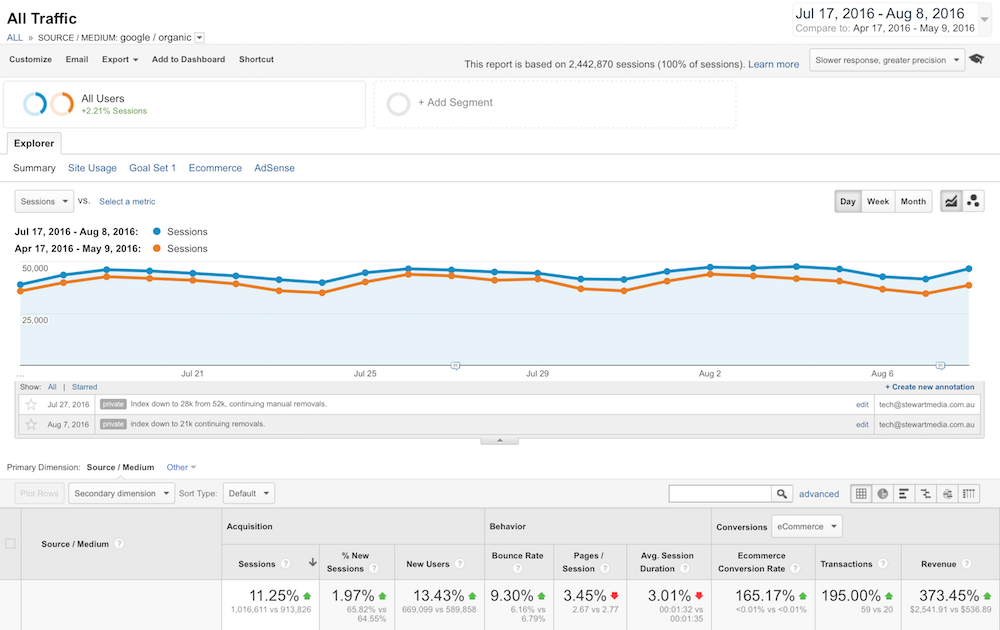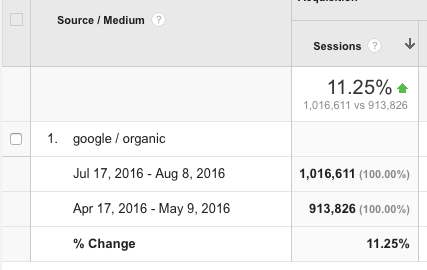SEO Subtraction Equals Addition
TRANSCRIPT:
Welcome back Rankers! I want to show you something this week that can be a little frustrating, especially when trying to explain it to clients. Much of the work we do here means having to wait for Google to catch up with us once we’ve completed a job. We have to go in everyday and do our checks and those sorts of things. We are often caught in a state of waiting for something to happen to observe results. Often, with the work we carry out, it isn’t short-term impact type of stuff, more of a long-term, gradual, cumulative effect.
I’ll show you what I mean.

This client here came to us around May this year. They sought our help as they’d experienced a massive drop in traffic, as it turned out due to a plugin they’d installed that had overwritten the robots.txt file. That’s not good obviously, as you don’t want plugins doing that. We fixed that problem but then noticed the sitemaps had about 52,000 URL’s in the sitemap.
When we looked closer at those URL’s it should have only had 6700. The reason being is that with WordPress.., (and many installs don’t handle this very well) especially some themes, when you add an image in WordPress it will actually create a different page, and for this particular site it was then allowing Google to come into every one of these image pages and index them. Now as you know by now, that’s bad, as it’s a low quality page and all it has on it is an image and some navigation. So, what we started to do was take those 52,000 URL’s, of which we only actually needed 6700, and redid the sitemaps.
One of the things you can actually do if you are on WordPress is use Yoast to fix some of this stuff. Just make sure you’re not letting Google index things like a media page. For most WordPress installs you’re only going to use posts, if you have something custom in that area, and also your landing pages which is typically it.
If anything else is being indexed such as tag pages or category pages that is possibly a problem and in this case the attachment pages.
Subtraction Equals Additions

Now the interesting thing here is 10% in the grand scheme of things might not sound much, however this is only over the course of three weeks. We now have the index down to 21,000 from 52,000 so the improvements are far from over. The 10% represents about 30,000 unique sessions per week. So you’re talking roughly 120,000 per month or about 1.5 million unique sessions over the course of the year based on the improvements thus far. Not too shabby if I do say so myself.
So doing all these little things and looking after the general health of the site and the health of the Google index is just so important, and a major factor in why we dedicate so much of our time towards it. Also for this site, I’m automating the removal of about 1,000 URLs per day. It then takes Google a while to catch up, so while you may have the URL removal happening, the algorithm doesn’t immediately know those URLs are gone. It takes time for it to catch up. So that’s what’s happening at the moment.
Baby Steps
I would hope to see this growth start to get a little steeper until we get closer to that 6700 URL mark in the index. Then I would expect to see it level out so we can divert our attention to other issues. I am loathe to tinker with other things though, unless it’s creating a new landing page or something similar, when you have something as large as the main task also happening.
The reason for not wanting to do too much is that you really won’t know what you should be doing until the main job is over. Once it’s over, we’ll know what we have to go after next. We know this is an issue at the moment, we don’t know how high it may get us on the page, but if we embarked on another ranking strategy right now whilst we still have all those other problems then we don’t know what other issues that might cause. If you go down that road, you’ll be working in the dark and can cause more harm than good.
Maintain the Basics
So one of your most important things, which I’ve emphasised over and over again, is to get your sitemap, your posts, pages, or actual number of real URLs you have on your site (pieces of content essentially, including your catalogue if it’s an eCommerce site), and when you do site: search for your domain name, those three should add up. Your sitemaps, the actual number of pages, and what Google has actually crawled, should all add up or at least be as close as possible, within 10-20%. If it’s a massive site, that’s a great accomplishment. If it’s only a ten-page site, you’re just being lazy.
Hopefully that’s helpful, and hopefully you get results like this when you clean up your index. We’ll see you next week. Bye.

Jim’s been here for a while, you know who he is.


